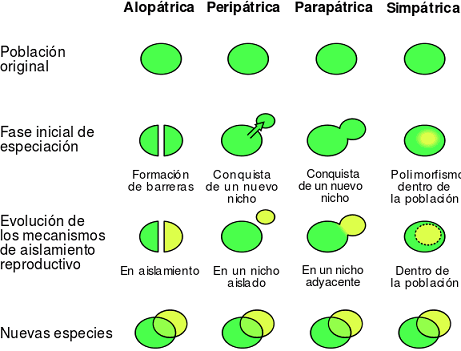Speciation
The speciation is the process of formation of new species by which a species is diversified into two or more different species.
The main cause of speciation is reproductive isolation, when a group of individuals in the population lose the possibility of reproducing with the rest. As a result, over time, a similar group will be created but with different adaptations, giving rise to a new species.
When two populations of the same species are isolated and are in different environmental conditions, their adaptation and evolution are different.
The main types of speciation are:
- Allopathic speciation. It occurs when the geographical separation of individuals in a population occurs. Because they are separated, there is reproductive isolation that prevents reproduction from occurring between individuals of the two new populations. Over time, the two populations differ genetically as the changes accumulate until they become two different species and their reproduction is impossible.
- Sympatric speciation. It occurs when some individuals in the population are reproductively isolated from others, without there being a geographical separation between the two groups. For example, when one group of individuals searches for a new type of food, it exploits a new ecological niche and reduces the flow of genes with the individuals of the other group. They are genetically differentiated until a time comes when, although they live together, reproduction between the two groups becomes impossible, obtaining two different species.
The reproductive isolation occurs when a certain factor hinders reproduction among individuals. For example:
- Seasonal or habitat isolation. When two potentially mating individuals have some kind of barrier, such as
- Habitat. Gasterosteur, a fish with a species that lives in fresh water and another that lives in the sea and only goes to fresh water to reproduce in spring and summer, which makes the two populations reproductively isolated by living in places with different saline concentrations.
- Seasonal. Individuals who reach their sexual maturity or flowering at different times, so they lose the possibility of reproduction.
- Habitat. Gasterosteur, a fish with a species that lives in fresh water and another that lives in the sea and only goes to fresh water to reproduce in spring and summer, which makes the two populations reproductively isolated by living in places with different saline concentrations.
- Sexual, behavioral, or conduct isolation. When two populations develop different courtship rituals. In dioecious species, it is necessary for males and females to meet, perform courtship and mating rituals, and copulate or release gametes so that reproduction can occur.
- Mechanical isolation. When there are two populations that attempt mating but there are morphological differences that prevent it (the genitalia do not complement each other) and fertilization cannot be carried out.
- Ecological insulation. When two populations living in the same habitat specialize in different ecological niches.

By Speciation_modes.svg: Ilmari Karonenderivative work: Mircalla22 (Speciation_modes.svg) [CC BY-SA 2.5-2.0-1.0, CC-BY-SA-3.0 or GFDL], via Wikimedia Commons